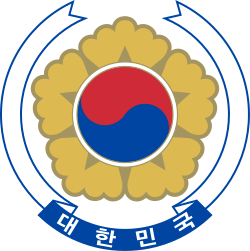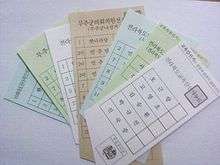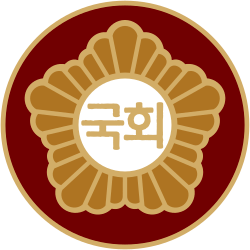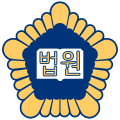Elections in South Korea
 |
|---|
| This article is part of a series on the politics and government of the Republic of Korea |
| Constitution |
|
Judiciary |
Elections in South Korea are held on national level to select the President and the National Assembly. Local elections are held every four years to elect governors, metropolitan mayors, municipal mayors, and provincial and municipal legislatures.
The president is directly elected for a single five-year term by plurality vote. The National Assembly has 300 members elected for a four-year term, 253 in single-seat constituencies and 47 members by proportional representation. Each individual party willing to represent its policies in the National Assembly is qualified on the legislative (general) election if: i) the national party-vote reaches over 3.00% on proportional contest or ii) more than 5 members of the party are elected from each of their first-past-the-post election constituencies.[1]
Since the 2017 presidential elections, South Korea has two main parties, the left-leaning Democratic Party of Korea and the conservative Liberty Korea Party. In addition, there are currently three significant minor parties: the centrist People's Party, the liberal-conservative Bareun Party and the progressive Justice Party.
Election Technology

Polling places are usually located in schools. During the absentee or early voting period, voters can vote at any polling place in the country. On election day, voters may only vote at polling places in their registered constituency. Korean voters mark paper ballots with a rubber stamp using red ink. There is one race per ballot paper; if there are multiple office up for election, ballot papers are color coded and voters are issued one ballot per race.[2]
Korea uses a central count model. After the polls close, ballot boxes are sealed and transported to the constituency's counting center. Traditionally, ballots were hand counted, but since around 2012, optical scanners have been used. The scanners resemble cash sorter machines, sorting the ballots into stacks by how they are voted. Stacks are then counted using machines resembling currency counting machines.[3]
Korean elections have been praised as a model of best practice.[2] However, the legality of the introduction of optical scan technology has been challenged and there have been allegations of rigged counting.[3]
Schedule
Election
| Position | 2017 | 2018 | 2019 | 2020 | 2021 | 2022 |
|---|---|---|---|---|---|---|
| Type | Presidential (May) | Local (June) | None | National Assembly (April) | None | Local (June) Presidential (March) |
| President | President | None | President | |||
| National Assembly | None | All seats | None | |||
| Provinces, cities and municipalities | None | All positions | None | All positions | ||
Inauguration
| Position | 2017 | 2018 | 2019 | 2020 | 2021 | 2022 |
|---|---|---|---|---|---|---|
| Type | Presidential (May) | Local (July) | None | National Assembly (May) | None | Local (July) Presidential (May) |
| President | May 10 | None | May 10 | |||
| National Assembly | None | May 30 | None | |||
| Provinces, cities and municipalities | None | July 1 | None | July 1 | ||
Latest elections
2016 legislative election
| Party | Constituency | Party list | Total seats |
+/– | |||||||
|---|---|---|---|---|---|---|---|---|---|---|---|
| Votes | % | Seats | +/– | Votes | % | Seats | +/– | ||||
| Democratic Party of Korea (더불어민주당) (DPK) 1 | 8,881,369 | 37.0 | 110 | 6,069,744 | 25.5 | 13 | 123 | ||||
| Saenuri Party (새누리당) (SP) 2 | 9,200,690 | 38.3 | 105 | 7,960,272 | 33.5 | 17 | 122 | ||||
| People's Party (국민의당) (PP) | 3,565,451 | 14.9 | 25 | (new) | 6,355,572 | 26.7 | 13 | (new) | 38 | (new) | |
| Justice Party (정의당) (JP) 3 | 395,357 | 1.6 | 2 | 1,719,891 | 7.2 | 4 | 6 | ||||
| Christian Liberal Party (기독자유당) (CLP) | 1,376 | 0.0 | 0 | (new) | 626,853 | 2.6 | 0 | (new) | 0 | (new) | |
| Minjoo Party (민주당) (MP) 4 | 17,034 | 0.1 | 0 | (new) | 209,872 | 0.9 | 0 | (new) | 0 | (new) | |
| Other parties | 257,879 | 1.1 | 0 | 818,773 | 3.4 | 0 | 0 | ||||
| Independents | 1,683,264 | 7.0 | 11 | N/A | 11 | ||||||
| Total | 24,002,420 | 100.0 | 253 | 23,760,977 | 100 | 47 | 300 | ||||
| Turnout: 58.0%[6] | |||||||||||
Seat changes are compared to previous election, not the outgoing Assembly
1 Comparison based on 2012 Democratic United Party result
2 Comparison includes members elected in 2012 for the Liberty Forward Party
3 Comparison based on 2012 Unified Progressive Party result
4 Non-parliamentary grouping: not to be confused with the larger Minjoo Party of Korea, more usually referred to as the Minjoo Party
2018 local election
2017 presidential election
Summary of past elections
Presidential elections
Legislative elections
Local elections
Notes
- ↑ Representation System(Elected Person) Archived April 22, 2008, at the Wayback Machine., the NEC, Retrieved on April 10, 2008
- 1 2 Tim Meisburger, Korean Elections: A Model of Best Practice, April 20, 2016.
- 1 2 Oglim, The South Korean 2012 Presidential Election was Fraudulent, Feb. 21, 2013. (archived version.)
- ↑ "4.13 총선" (in Korean). Naver News. 13 April 2016. Retrieved 13 April 2016.
- ↑ "개표진행상황" (in Korean). Republic of Korea National Election Commission. 14 April 2016. Retrieved 14 April 2016.
- ↑ "20대 총선 잠정투표율 58.0%…19대보다 3.8%p↑" (in Korean). Yonhap News. 13 April 2016. Retrieved 13 April 2016.
See also
Further reading
- Nahm, A.C. (1996). Korea: A history of the Korean people (rev. ed.). Seoul: Hollym. ISBN 978-1-56591-070-6.
- Lee, Il-cheong (이일청) (1993). 인명국사대사전 (Inmyeong guksa daesajeon, Unabridged biographical dictionary of Korean history. Seoul: Goryeo Munhaksa.
- Lee, Ki-baik (1984). A new history of Korea (rev ed.). Seoul: Ilchokak. ISBN 978-89-337-0204-8.
External links
- Overview of candidates, parties and outcomes of South Korean elections since 1952 (with minor flaws like 이시영 missing in the 1952 page and wrong year of Park's resignation in the 1960 page)
- Comment on the October 26, 2005 by-election results


